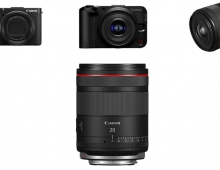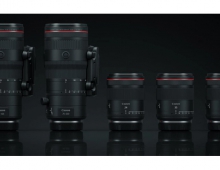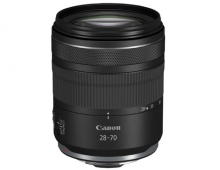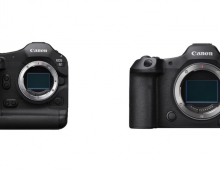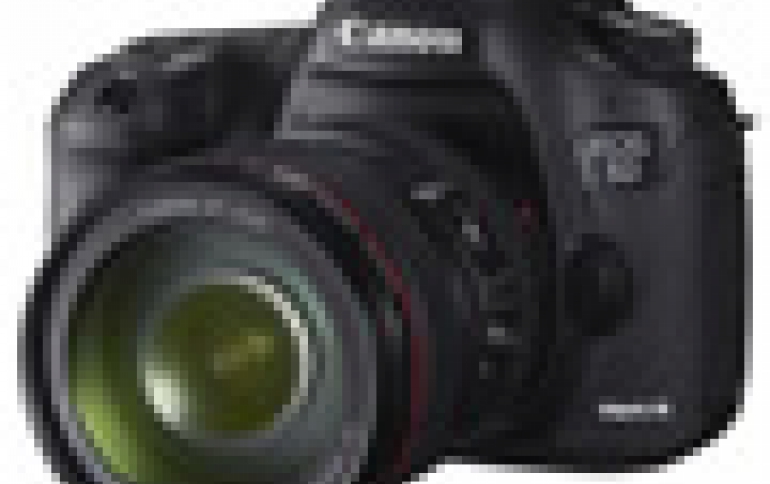
Canon Announces The EOS 5D Mark III Digital SLR Camera
On the 25th anniversary of its EOS System, Canon
announced its latest model, the new EOS 5D Mark III
Digital SLR Camera.
Positioned between the EOS 5D Mark II and Canon's
top-of-the-line EOS-1D X model, the EOS 5D Mark III
promises to deliver superb image quality, thanks to a new
22.3-megapixel full-frame Canon CMOS sensor, a DIGIC 5+
Imaging Processor, a 61-point High Density Reticular
Autofocus (AF) System and six frames-per-second (fps)
continuous shooting speed. The EOS 5D Mark III also
incorporates enhanced video features for professionals in
the fields of cinematography, television production and
documentary filmmaking, including better noise reduction,
longer recording times and a built-in headphone jack for
audio monitoring.
 The EOS 5D Mark III inherits many features from Canon's
recently announced flagship DSLR, the EOS-1D X, including
a DIGIC 5+ Imaging Processor and a 61-point High Density
Reticular AF array with up to 41 cross-type points and
five dual cross-type points available, depending on the
lens in use. The enhanced processing power enables
continuous shooting of up to six fps, exceeding the speed
of the EOS 5D Mark II model by more than 50 percent, and
with improved weather resistance the EOS 5D Mark III is a
serious option for sports and wildlife photographers.
The EOS 5D Mark III inherits many features from Canon's
recently announced flagship DSLR, the EOS-1D X, including
a DIGIC 5+ Imaging Processor and a 61-point High Density
Reticular AF array with up to 41 cross-type points and
five dual cross-type points available, depending on the
lens in use. The enhanced processing power enables
continuous shooting of up to six fps, exceeding the speed
of the EOS 5D Mark II model by more than 50 percent, and
with improved weather resistance the EOS 5D Mark III is a
serious option for sports and wildlife photographers.
This new model captures 1080p Full HD video at 24p (23.976), 25p, and 30p (29.97) fps; 720p HD recording at 60 (59.94) and 50 fps; and SD recording at 30 (29.97) and 25 fps.
The EOS 5D Mark III includes new H.264 video compression formats to simplify and speed up post-production work: intraframe (ALL-I) compression for an editing-friendly format and interframe (IPB) compression for greater data storage efficiency. Like the EOS-1D X, the 5D Mark III also includes two methods of SMPTE-compliant timecode embedding, Rec Run and Free Run, allowing video footage from multiple cameras and separate audio recordings to be synced together in post production.
Accommodating documentary filmmakers, and event videographers using EOS DSLR cameras, the 5D Mark III includes the ability to record video continuously up to 29 minutes and 59 seconds across multiple 4GB files. Long-form filmmakers will enjoy the camera's automatic file splitting in combination with the extended memory capacity offered by dual card slots.
The Canon EOS 5D Mark III also includes manual audio level control with 64 levels, adjustable both before and during movie recording. There is also an automatic audio level setting, or sound recording can be turned off entirely. A wind filter is also included. Sound can be recorded either through the internal monaural microphone or via an optional external microphone through the stereo mic input. Notably, the EOS 5D Mark III is the first EOS Digital SLR to feature a built-in headphone jack for real-time audio monitoring during video capture.
Adjustable from ISO 100 to 25,600 within its standard range, the new model also offers a low ISO 50 setting for studio and landscape photography and two extended ISO settings of 51,200 and 102,400, well suited for law enforcement, government or forensic field applications.
The new 5D Mark III is also equipped with Canon's EOS Integrated Cleaning System, featuring a Self Cleaning Sensor Unit with a fluorine coating that repels dust and dirt particles.
The EOS 5D Mark III?s new DIGIC 5+ Imaging Processor is 17 times faster than the DIGIC 4. New features include six fps continuous shooting, HDR and Multiple Exposure modes, in-camera RAW processing, a comparative playback function, Scene Intelligent Auto mode, two forms of movie compression, and support for high-speed UDMA 7 Compact Flash memory cards.
Another feature enhanced by the DIGIC 5+ Imaging Processor is the EOS 5D Mark III?s choice of reduced resolution M-RAW (10.5 megapixel) and S-RAW (5.5 megapixel) recording modes.
All AF functions now have their own menu tab for quick access (formerly AF custom functions in previous EOS models). A new AF Configuration Tool allows for customized setting of tracking sensitivity, the acceleration and deceleration of tracking subjects, and AF point auto switching, all of which are accessed and adjusted via the new AF menu tab. A built-in Feature Guide advises photographers on which settings to use according to subject matter.
The EOS 5D Mark III uses the same high-performance AI Servo III AF tracking algorithm as the flagship EOS-1D X professional DSLR.
Similar to the AF point selection options offered in the EOS 7D and EOS-1D X camera models, the EOS 5D Mark III offers six AF point selection modes: Spot, Single Point, Single Point with surrounding four points, Single Point with surrounding eight points, Zone selection and Automatic AF point selection.
Complementing the EOS 5D Mark III camera's 61-point AF system is Canon's 63-zone iFCL dual layer metering system. The 'FCL' stands for 'Focus, Color and Luminance,' and references the fact that the metering system not only measures color and luminance data, but also analyzes the data provided by each point of the AF system. Canon's iFCL metering keeps exposure levels stable from shot to shot, even as the light source changes.
The EOS 5D Mark III camera features a built-in HDR mode, merging three images at various exposure levels into a single image, in-camera, for photographs of landscapes and architecture with enhanced tonal gradation beyond the range of the naked eye. The exposure levels in the camera's HDR mode can be set to cover a range of up to ±3 stops, in a choice of five settings: Natural, Art Standard, Art Vivid, Art Bold and Art Embossed providing unique visual effects. The EOS 5D Mark III's standard Auto Exposure Bracketing function has been upgraded to allow for up to seven exposures per sequence, and exposure compensation can now be set for up to +/- 5EV.
The EOS 5D Mark III is the second EOS Digital SLR after the EOS-1D X to feature Multiple Exposure capabilities with the ability to combine up to nine individual images into a single composite image, with no need for post-processing in a computer. Four different compositing methods are provided for maximum creative control, including Additive, Average, Bright and Dark. Compositing results can be viewed in real time on the camera?s LCD monitor, and there is a one-step Undo command that allows photographers to delete an image and try again if desired. The EOS 5D Mark III camera's Multiple Exposure mode even allows photographers to specify a previously captured RAW image as the starting point for a new Multiple Exposure composite image, or shoot continuously when photographing moving subjects.
A new feature seen for the first time in the EOS System on the 5D Mark III is Comparative Playback allowing photographers to display two images side by side on the camera's 3.2-inch LCD screen. The images can be displayed with a histogram to check exposure levels, or magnified to check for focus or facial expressions.
The EOS 5D Mark III features a rugged camera body with magnesium alloy body covers and a stainless steel lens mount. The camera's newly developed shutter unit has a durability rating of 150,000 exposures, and shutter release lag time has been reduced to 59 milliseconds.
The EOS 5D Mark III uses the same LP-E6 lithium-ion battery pack as other popular EOS cameras like the 5D Mark II, 7D and 60D. Battery life is estimated at 950 exposures at normal temperatures, an improvement of 100 exposures more than the EOS 5D Mark II. The EOS 5D Mark III body weighs approximately 33.5 oz. with a battery installed, and the dimensions are approximately 6.0 x 4.6 x 3.0 inches.
The EOS 5D Mark III incorporates Silent shooting modes, available for low-speed continuous shooting as well as single exposures. For better file management especially when working with multiple cameras, the new model also supports custom file names. There is also a new image rating feature that lets photographers rank their photos from 1 to 5 stars for quick editing.
The EOS 5D Mark III features a 3.2-inch Clear View II LCD screen with 1,040,000 dot resolution. This is the same screen that's used in the top-of-the-line EOS-1D X. The camera's optical viewfinder has been upgraded to approximately 100 percent coverage, and it features an Intelligent Viewfinder display with an optional grid on demand. The EOS 5D Mark III also has a built-in Dual Axis Electronic Level that can be displayed on both the LCD screen and the optical viewfinder.
The EOS 5D Mark III accepts both Compact Flash Type 1 and SD/SDHC/SDXC memory cards in a dual card slot configuration. Three recording methods are supported: Record the same data to both cards, record different file sizes or types to each card, or automatically switch to the second card when the first card is full.
The EOS 5D Mark III DSLR also has a number of new optional accessories, including the new Canon Wireless File Transmitter WFT-E7A featuring wireless LAN support for 802.11 a/b/g/n signal protocols for various network environments. The WFT-E7A connects to the camera through its USB port and includes a built-in gigabit Ethernet connection, time syncing for multiple cameras on the same network, FTP mode, EOS Utility mode, WFT Server mode and Media Server mode.
The EOS 5D Mark III also has an optional Canon GPS Receiver GP-E2, which can be connected to the camera via the accessory shoe or a USB cable. With a GPS logging function built-in, the GP-E2 will log latitude, longitude, elevation, and the Universal Time Code ? and allow viewing of camera movement on a PC after shooting. With its built-in compass, the GP-E2 receiver will also record camera direction when shooting, even when shooting vertically. The Canon GPS Receiver GP-E2 is compatible with the EOS-1D X and EOS 7D1 as well as the EOS 5D Mark III.
Battery Grip BG-E11 is an optional accessory for the EOS 5D Mark III that accepts one or two LP-E6 lithium-ion battery packs or a set of six AA-size batteries.
The Canon EOS 5D Mark III Digital SLR camera is expected to be available at the end of March 2012 and will be sold in a body-only configuration at an estimated retail price of $3,499.00. The EOS 5D Mark III will also be available with the EF24-105mm f/4L IS USM zoom lens in a kit for an estimated retail price of $4,299.00. The Wireless File Transmitter WFT-E7A is scheduled to be available by the end of April 2012 at an estimated retail price of $849.99. Availability for GPS Receiver GP-E2 is expected by the end of April 2012, with an estimated retail price of $390.00.Battery Grip BG-E11 is scheduled to be available at the end of April 2012 for an estimated retail price of $490.00.
 The EOS 5D Mark III inherits many features from Canon's
recently announced flagship DSLR, the EOS-1D X, including
a DIGIC 5+ Imaging Processor and a 61-point High Density
Reticular AF array with up to 41 cross-type points and
five dual cross-type points available, depending on the
lens in use. The enhanced processing power enables
continuous shooting of up to six fps, exceeding the speed
of the EOS 5D Mark II model by more than 50 percent, and
with improved weather resistance the EOS 5D Mark III is a
serious option for sports and wildlife photographers.
The EOS 5D Mark III inherits many features from Canon's
recently announced flagship DSLR, the EOS-1D X, including
a DIGIC 5+ Imaging Processor and a 61-point High Density
Reticular AF array with up to 41 cross-type points and
five dual cross-type points available, depending on the
lens in use. The enhanced processing power enables
continuous shooting of up to six fps, exceeding the speed
of the EOS 5D Mark II model by more than 50 percent, and
with improved weather resistance the EOS 5D Mark III is a
serious option for sports and wildlife photographers.
This new model captures 1080p Full HD video at 24p (23.976), 25p, and 30p (29.97) fps; 720p HD recording at 60 (59.94) and 50 fps; and SD recording at 30 (29.97) and 25 fps.
The EOS 5D Mark III includes new H.264 video compression formats to simplify and speed up post-production work: intraframe (ALL-I) compression for an editing-friendly format and interframe (IPB) compression for greater data storage efficiency. Like the EOS-1D X, the 5D Mark III also includes two methods of SMPTE-compliant timecode embedding, Rec Run and Free Run, allowing video footage from multiple cameras and separate audio recordings to be synced together in post production.
Accommodating documentary filmmakers, and event videographers using EOS DSLR cameras, the 5D Mark III includes the ability to record video continuously up to 29 minutes and 59 seconds across multiple 4GB files. Long-form filmmakers will enjoy the camera's automatic file splitting in combination with the extended memory capacity offered by dual card slots.
The Canon EOS 5D Mark III also includes manual audio level control with 64 levels, adjustable both before and during movie recording. There is also an automatic audio level setting, or sound recording can be turned off entirely. A wind filter is also included. Sound can be recorded either through the internal monaural microphone or via an optional external microphone through the stereo mic input. Notably, the EOS 5D Mark III is the first EOS Digital SLR to feature a built-in headphone jack for real-time audio monitoring during video capture.
Adjustable from ISO 100 to 25,600 within its standard range, the new model also offers a low ISO 50 setting for studio and landscape photography and two extended ISO settings of 51,200 and 102,400, well suited for law enforcement, government or forensic field applications.
The new 5D Mark III is also equipped with Canon's EOS Integrated Cleaning System, featuring a Self Cleaning Sensor Unit with a fluorine coating that repels dust and dirt particles.
The EOS 5D Mark III?s new DIGIC 5+ Imaging Processor is 17 times faster than the DIGIC 4. New features include six fps continuous shooting, HDR and Multiple Exposure modes, in-camera RAW processing, a comparative playback function, Scene Intelligent Auto mode, two forms of movie compression, and support for high-speed UDMA 7 Compact Flash memory cards.
Another feature enhanced by the DIGIC 5+ Imaging Processor is the EOS 5D Mark III?s choice of reduced resolution M-RAW (10.5 megapixel) and S-RAW (5.5 megapixel) recording modes.
All AF functions now have their own menu tab for quick access (formerly AF custom functions in previous EOS models). A new AF Configuration Tool allows for customized setting of tracking sensitivity, the acceleration and deceleration of tracking subjects, and AF point auto switching, all of which are accessed and adjusted via the new AF menu tab. A built-in Feature Guide advises photographers on which settings to use according to subject matter.
The EOS 5D Mark III uses the same high-performance AI Servo III AF tracking algorithm as the flagship EOS-1D X professional DSLR.
Similar to the AF point selection options offered in the EOS 7D and EOS-1D X camera models, the EOS 5D Mark III offers six AF point selection modes: Spot, Single Point, Single Point with surrounding four points, Single Point with surrounding eight points, Zone selection and Automatic AF point selection.
Complementing the EOS 5D Mark III camera's 61-point AF system is Canon's 63-zone iFCL dual layer metering system. The 'FCL' stands for 'Focus, Color and Luminance,' and references the fact that the metering system not only measures color and luminance data, but also analyzes the data provided by each point of the AF system. Canon's iFCL metering keeps exposure levels stable from shot to shot, even as the light source changes.
The EOS 5D Mark III camera features a built-in HDR mode, merging three images at various exposure levels into a single image, in-camera, for photographs of landscapes and architecture with enhanced tonal gradation beyond the range of the naked eye. The exposure levels in the camera's HDR mode can be set to cover a range of up to ±3 stops, in a choice of five settings: Natural, Art Standard, Art Vivid, Art Bold and Art Embossed providing unique visual effects. The EOS 5D Mark III's standard Auto Exposure Bracketing function has been upgraded to allow for up to seven exposures per sequence, and exposure compensation can now be set for up to +/- 5EV.
The EOS 5D Mark III is the second EOS Digital SLR after the EOS-1D X to feature Multiple Exposure capabilities with the ability to combine up to nine individual images into a single composite image, with no need for post-processing in a computer. Four different compositing methods are provided for maximum creative control, including Additive, Average, Bright and Dark. Compositing results can be viewed in real time on the camera?s LCD monitor, and there is a one-step Undo command that allows photographers to delete an image and try again if desired. The EOS 5D Mark III camera's Multiple Exposure mode even allows photographers to specify a previously captured RAW image as the starting point for a new Multiple Exposure composite image, or shoot continuously when photographing moving subjects.
A new feature seen for the first time in the EOS System on the 5D Mark III is Comparative Playback allowing photographers to display two images side by side on the camera's 3.2-inch LCD screen. The images can be displayed with a histogram to check exposure levels, or magnified to check for focus or facial expressions.
The EOS 5D Mark III features a rugged camera body with magnesium alloy body covers and a stainless steel lens mount. The camera's newly developed shutter unit has a durability rating of 150,000 exposures, and shutter release lag time has been reduced to 59 milliseconds.
The EOS 5D Mark III uses the same LP-E6 lithium-ion battery pack as other popular EOS cameras like the 5D Mark II, 7D and 60D. Battery life is estimated at 950 exposures at normal temperatures, an improvement of 100 exposures more than the EOS 5D Mark II. The EOS 5D Mark III body weighs approximately 33.5 oz. with a battery installed, and the dimensions are approximately 6.0 x 4.6 x 3.0 inches.
The EOS 5D Mark III incorporates Silent shooting modes, available for low-speed continuous shooting as well as single exposures. For better file management especially when working with multiple cameras, the new model also supports custom file names. There is also a new image rating feature that lets photographers rank their photos from 1 to 5 stars for quick editing.
The EOS 5D Mark III features a 3.2-inch Clear View II LCD screen with 1,040,000 dot resolution. This is the same screen that's used in the top-of-the-line EOS-1D X. The camera's optical viewfinder has been upgraded to approximately 100 percent coverage, and it features an Intelligent Viewfinder display with an optional grid on demand. The EOS 5D Mark III also has a built-in Dual Axis Electronic Level that can be displayed on both the LCD screen and the optical viewfinder.
The EOS 5D Mark III accepts both Compact Flash Type 1 and SD/SDHC/SDXC memory cards in a dual card slot configuration. Three recording methods are supported: Record the same data to both cards, record different file sizes or types to each card, or automatically switch to the second card when the first card is full.
The EOS 5D Mark III DSLR also has a number of new optional accessories, including the new Canon Wireless File Transmitter WFT-E7A featuring wireless LAN support for 802.11 a/b/g/n signal protocols for various network environments. The WFT-E7A connects to the camera through its USB port and includes a built-in gigabit Ethernet connection, time syncing for multiple cameras on the same network, FTP mode, EOS Utility mode, WFT Server mode and Media Server mode.
The EOS 5D Mark III also has an optional Canon GPS Receiver GP-E2, which can be connected to the camera via the accessory shoe or a USB cable. With a GPS logging function built-in, the GP-E2 will log latitude, longitude, elevation, and the Universal Time Code ? and allow viewing of camera movement on a PC after shooting. With its built-in compass, the GP-E2 receiver will also record camera direction when shooting, even when shooting vertically. The Canon GPS Receiver GP-E2 is compatible with the EOS-1D X and EOS 7D1 as well as the EOS 5D Mark III.
Battery Grip BG-E11 is an optional accessory for the EOS 5D Mark III that accepts one or two LP-E6 lithium-ion battery packs or a set of six AA-size batteries.
The Canon EOS 5D Mark III Digital SLR camera is expected to be available at the end of March 2012 and will be sold in a body-only configuration at an estimated retail price of $3,499.00. The EOS 5D Mark III will also be available with the EF24-105mm f/4L IS USM zoom lens in a kit for an estimated retail price of $4,299.00. The Wireless File Transmitter WFT-E7A is scheduled to be available by the end of April 2012 at an estimated retail price of $849.99. Availability for GPS Receiver GP-E2 is expected by the end of April 2012, with an estimated retail price of $390.00.Battery Grip BG-E11 is scheduled to be available at the end of April 2012 for an estimated retail price of $490.00.




